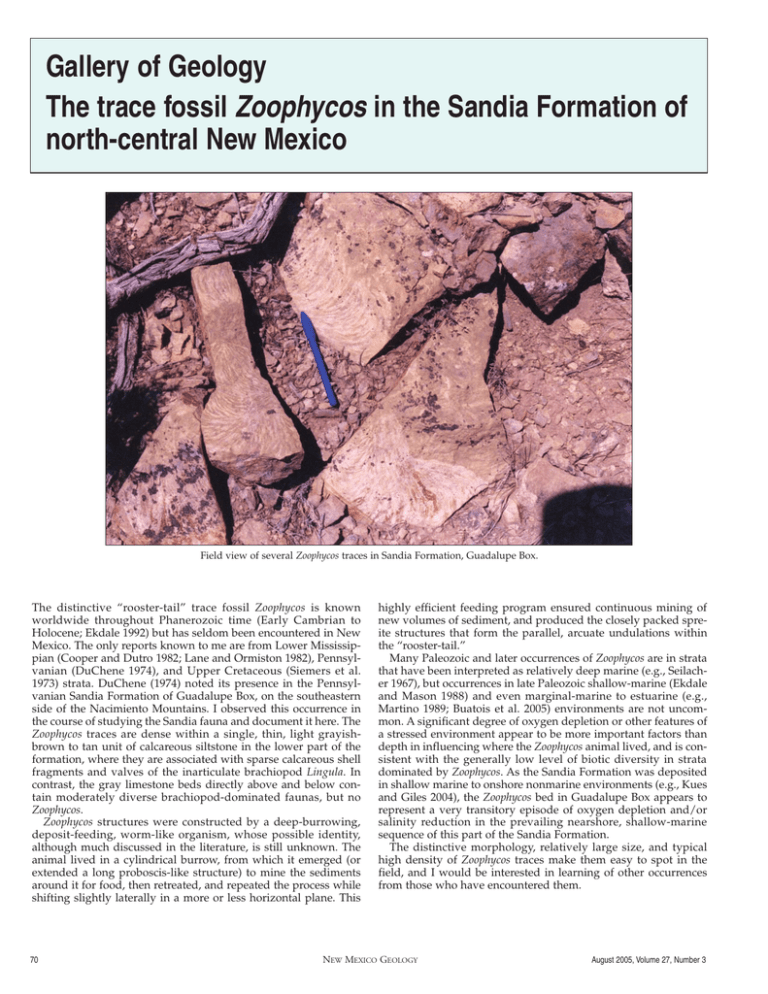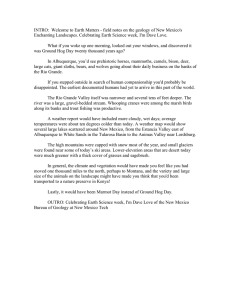Gallery of Geology Zoophycos north-central New Mexico
advertisement

Gallery of Geology The trace fossil Zoophycos in the Sandia Formation of north-central New Mexico Field view of several Zoophycos traces in Sandia Formation, Guadalupe Box. The distinctive “rooster-tail” trace fossil Zoophycos is known worldwide throughout Phanerozoic time (Early Cambrian to Holocene; Ekdale 1992) but has seldom been encountered in New Mexico. The only reports known to me are from Lower Mississippian (Cooper and Dutro 1982; Lane and Ormiston 1982), Pennsylvanian (DuChene 1974), and Upper Cretaceous (Siemers et al. 1973) strata. DuChene (1974) noted its presence in the Pennsylvanian Sandia Formation of Guadalupe Box, on the southeastern side of the Nacimiento Mountains. I observed this occurrence in the course of studying the Sandia fauna and document it here. The Zoophycos traces are dense within a single, thin, light grayishbrown to tan unit of calcareous siltstone in the lower part of the formation, where they are associated with sparse calcareous shell fragments and valves of the inarticulate brachiopod Lingula. In contrast, the gray limestone beds directly above and below contain moderately diverse brachiopod-dominated faunas, but no Zoophycos. Zoophycos structures were constructed by a deep-burrowing, deposit-feeding, worm-like organism, whose possible identity, although much discussed in the literature, is still unknown. The animal lived in a cylindrical burrow, from which it emerged (or extended a long proboscis-like structure) to mine the sediments around it for food, then retreated, and repeated the process while shifting slightly laterally in a more or less horizontal plane. This 70 highly efficient feeding program ensured continuous mining of new volumes of sediment, and produced the closely packed spreite structures that form the parallel, arcuate undulations within the “rooster-tail.” Many Paleozoic and later occurrences of Zoophycos are in strata that have been interpreted as relatively deep marine (e.g., Seilacher 1967), but occurrences in late Paleozoic shallow-marine (Ekdale and Mason 1988) and even marginal-marine to estuarine (e.g., Martino 1989; Buatois et al. 2005) environments are not uncommon. A significant degree of oxygen depletion or other features of a stressed environment appear to be more important factors than depth in influencing where the Zoophycos animal lived, and is consistent with the generally low level of biotic diversity in strata dominated by Zoophycos. As the Sandia Formation was deposited in shallow marine to onshore nonmarine environments (e.g., Kues and Giles 2004), the Zoophycos bed in Guadalupe Box appears to represent a very transitory episode of oxygen depletion and/or salinity reduction in the prevailing nearshore, shallow-marine sequence of this part of the Sandia Formation. The distinctive morphology, relatively large size, and typical high density of Zoophycos traces make them easy to spot in the field, and I would be interested in learning of other occurrences from those who have encountered them. NEW MEXICO GEOLOGY August 2005, Volume 27, Number 3 Slab with two large Zoophycos traces in contact; height of slab is 21 cm. References Bromley, R. G., 1996, Trace fossils, 2nd edition: London, Chapman and Hall, 361 pp. Buatois, L. A., and 7 others, 2005, Colonization of brackish-water systems through time—evidence from the trace-fossil record: Palaios, v. 20, pp. 321–347. Cooper, G. A., and Dutro, J. T., Jr., 1982, Devonian brachiopods of New Mexico: Bulletins of American Paleontology, v. 82 and 83, no. 315, 215 pp. DuChene, H. R., 1974, Pennsylvanian rocks of north-central New Mexico; in Siemers, C. T., Woodward, L. A., and Callender, J. F. (eds.), Ghost Ranch: New Mexico Geological Society, Guidebook 25, pp. 159–162. Ekdale, A. A., 1992, Muckraking and mudslinging—the joys of deposit-feeding; in Trace fossils: The Paleontological Society, Short Courses in Paleontology no. 5, pp. 145–171. Ekdale, A. A., and Mason, T. R., 1988, Characteristic trace-fossil associations in oxygen-poor sedimentary environments: Geology, v. 16, pp. 720–723. Kues, B. S., and Giles, K. A., 2004, The late Paleozoic Ancestral Rocky Moun- tains system in New Mexico; in Mack, G. H., and Giles, K. A. (eds.), The geology of New Mexico, a geologic history: New Mexico Geological Society, Special Publication 11, pp. 95–136. Lane, H. R., and Ormiston, A. R., 1982, Waulsortian facies, Sacramento Mountains, New Mexico—guide for an international field seminar, March 2–6, 1982; in Bolton, K., Lane, H. R., and LeMone, D. V. (eds.), Symposium on the paleoenvironmental setting and distribution of the Waulsortian facies: El Paso Geological Society and University of Texas at El Paso, pp. 115–182. Martino, R. L., 1989, Trace fossils from marginal marine facies of the Kanawha Formation (Middle Pennsylvanian), West Virginia: Journal of Paleontology, v. 63, pp. 389–403. Seilacher, A., 1967, Bathymetry of trace fossils: Marine Geology, v. 5, pp. 413–428. Siemers, C. T., Flesch, G. A., and Ruetschilling, R. L., 1973, The distribution of trace fossils in the upper part of the Morrison Formation and the Dakota Formation in part of the southeastern San Juan Basin, New Mexico; in Fassett, J. E. (ed.), Cretaceous and Tertiary rocks of the southern Colorado Plateau: Memoir of the Four Corners Geological Society, p. 215. —Barry S. Kues University of New Mexico August 2005, Volume 27, Number 3 NEW MEXICO GEOLOGY 71




